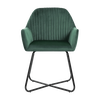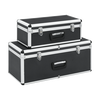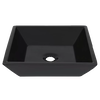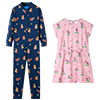Choosing the best wall panelling for your home
Wall panelling is a trend that’s currently taking over other conventional ways of wall finishing, like painting, tiles, and wallpapering. The main advantages of wall panelling range from hygiene to durability and cost. Wall panelling can be used to conceal unsightly features or design flaws, such as pipework and exposed wiring, which is not possible with other decorative elements.
In addition, the ease of installing wall panels on top of existing structures to elevate the look of your home is quite impressive. And unlike other finishes, they don't require much labour or time. Wall panelling is also a great way to add personality to your space. Whether you have a rustic home or looking to add traditional charm to a room, wall panelling is a good way to lift a space.
In this easy guide, we’ll discuss everything you need to know about choosing wall panelling. We’ll examine the various features you need to look out for so that you can choose the best wall panels that will add functionality and style to your space.
What’s the best material for wall panelling?
Wall panelling is available in a range of materials, which are durable and easy to maintain. The wall panels are mounted to the wall using screws or installed on a metal grid frame fixed on the wall. Below, we discuss the various wall panelling materials you can choose from.
Wood
Natural wood is the most popular material for modern wall panelling because it adds natural beauty, warmth, elegance, and richness to a space. Unlike cladding tiles, wood has fewer grouting lines that trap dirt.
Another advantage of wood panelling is that they are easy to maintain and repair. They can be sanded down and resealed to retain their original look if the surface has been bruised or damaged. However, wooden panels are not resistant to moisture, and they are also at risk of termite attacks.
MDF
MDF (Medium-density fibreboard) is a composite wood item manufactured from wood chippings glued together under heat or pressure. The main advantage of MDF is that it is cheaper but looks just like natural wood, which makes it a great alternative to wood.
The material is also flexible, allowing you to achieve intricate designs and patterns. Wall panels made from MDF can be finished in paint, metallic finish, and other options. However, it's advisable not to use MDF wall panels on a wall with seepage issues because the material tends to absorb water and swell, eventually disintegrating.
Plastic
Decorative wall panels made from plastic are waterproof, making them a great choice for moisture-laden areas like the bathroom and kitchen. They are also lightweight, easy to install, and don't attract dust. In addition, they have a non-porous surface that does not promote the growth of mildew or mould.
For those looking for versatility, plastic wall panelling is available in a wide range of colours. You can also find them as 3D panels, adding depth, texture, and pattern to your space. However, since plastic wall panels are the final finish, you must take caution not to hit them with a sharp object that can cause scratches.
Remember, screwing or nailing these panels can be challenging. You cannot use the screw again once it goes wrong.
Veneer
Veneer is a thin layer of wood that can be fixed on a backing board to create a wall panel. The material looks like real wood but is cheaper than natural wood. They are also lightweight and easy to install.
One of the main advantages of veneer is that it makes it possible to create a large wall panelling surface without grooves. This also makes it easier for designers to explore different designs for a wall panel. In addition, veneer is available in the same colour range of wood but with different wood grains.
Leather
Leather wall panels add beautiful colour, texture, and warmth to a space. They also reduce noise and can last for many years if well taken care of. In addition, the warmth that leather lends to a space is unmatched. You can use it in any room, and it will look sophisticated and striking without being overpowering.
Leather is a great option for the interior, where noise is an issue. It can also be treated with water-resistant finishes for areas with high moisture areas like bathrooms and kitchens. However, leather is expensive.
Amazing wall panelling ideas to enhance your walls
Panelling was initially used to provide additional insulation and durability for walls. Today, it's mostly used as a decorative element that adds charm, texture, and character to a space. One of the main traits of wall panelling is that it isn't as disruptive as many people think, and a competent DIYer can easily do the job. We've put together some great wall panelling ideas to suit every kind of home, whether classic or modern.
Use wood wall panels in a bathroom
Too much stone and tile can sometimes make a bathroom feel cold and sterile but introducing wood wall panels to your bathroom is a great way to add warmth to the space. Mixing materials can help break the monotony of common bathroom wall finishes and give the room a more modern and stylish appearance.
Pretty-up wall panels with decorative drawings
Add a fancy twist on plain white walls with a repeat motif in a contrasting colour. This will add an ornamental element to your space and create a decorative backdrop that doesn’t strain your eyes. Choose a practical paint finish for panelled walls. You can go with eggshell paint in a low-sheen finish, which is easy to wipe clean and more durable than emulsion.
Opt for fluted panelling for a contemporary feel
Fluting is one of the growing trends in interior design. It's often used to create interest and texture in a space. You can also use it as a partition wall to add character to a contemporary dining room with limited architectural detailing. Fluted wood wall panels will add warmth, creating a minimalist decorating scheme and making your space welcoming.
Make a secret door in your wall panel
Disguising a door in a room is a clever wall panelling idea you should try. You can do this for some hidden storage, such as an under-stair storage or an en suite bathroom. When the door is closed, it leaves a clean look so no one will anticipate the existence of a door there.
Go with practical panelling in areas with high traffic
Stair panelling ideas incorporate a practical element and decorative effect. Using wall panels on the lower section of walls in high-traffic areas will boost the longevity of the plasterwork.
In addition, using wipe-clean paint will make it easier to remove marks and fingerprints. Using plain painted wall panels on the lower section of the walls allows you to give the upper part of the space a more decorative treatment. You can add attention-grabbing wallpapers to the upper section to draw the eye upwards.
Wall panelling maintenance tips
Like other features in your home, wall panels are prone to wear and tear. Proper maintenance is essential in ensuring the panels remain in top condition for many years. Here are a few care tips for wall panels:
Know your wall panels
The material used to construct a wall panel may partly determine how you maintain it. This is because different materials require different care, so you must know your panels. For example, most cleaners are too harsh and will damage wood or remove its finish. On the other hand, plastic is fine with virtually any cleaner. You may have to refinish the panels at some points
Regular dusting or vacuuming
Well-patterned wall panels are great at hiding dirt, but even the smoothest surfaces accumulate dirt. It's important to clean the surface of your panels regularly using a lint-free cloth or feather duster. For effective cleaning, you may want to use a vacuum cleaner. Attach a soft brush to the wand and worth methodically across the panel's surface, starting at the top as you move down.
Keep your panels away from sunlight
Most wall panel finishes tend to fade when exposed to sunlight for extended periods of time. When installing wall panels, ensure they are away from windows, doors, or other inlets of sunlight. Alternatively, you can use curtains or blinds on your windows to reduce the amount of light falling on your wall panels.
Keep your wall panels dry
Wall panel materials like wood and MDF get damaged when exposed to wet areas. So, you may want to avoid using them in bathrooms and kitchens. Protecting your panels from water and cleaning off any splashes immediately is important.
Shop wall panels at vidaXL
Here at vidaXL, we have a large collection of wall panels to suit every home. Our wall panels come in different materials, sizes, and styles to meet your design needs. Whether you have a classic or contemporary home, we have the perfect wall panels for you.
Our wall panels are designed for quick installation and a beautiful finish. We only source from the best manufacturers to ensure our customers get panels that meet the highest quality standards. Browse our collection today to find the best wall panels for your home.































































